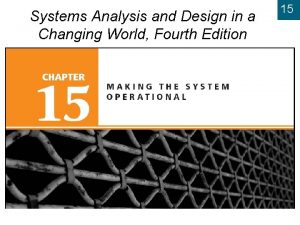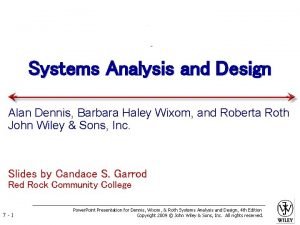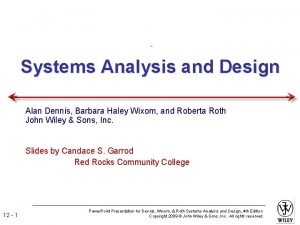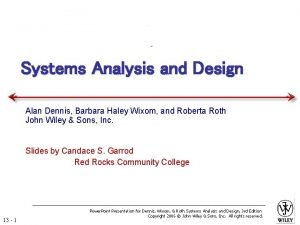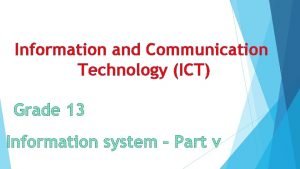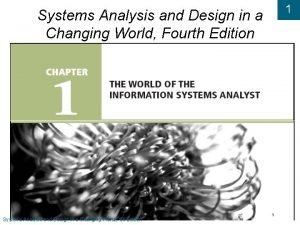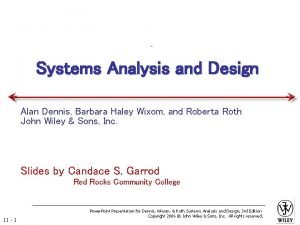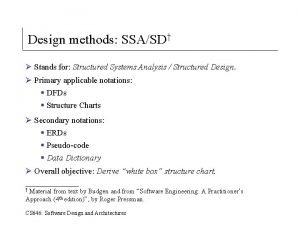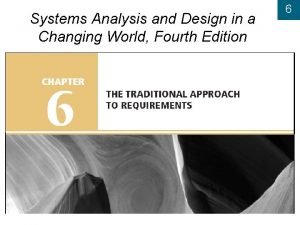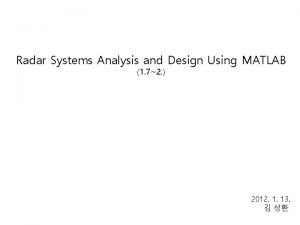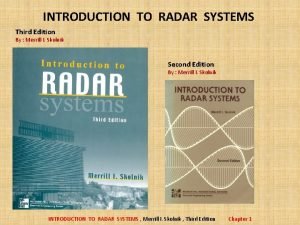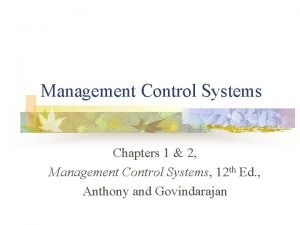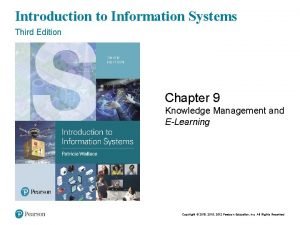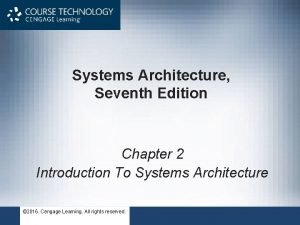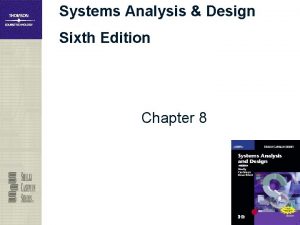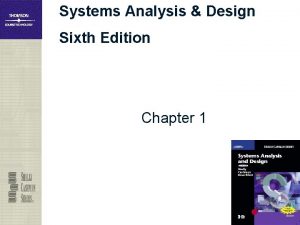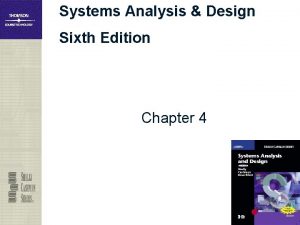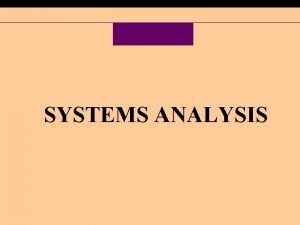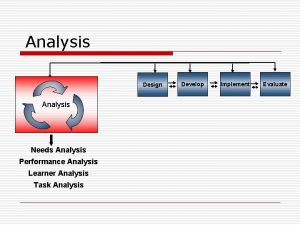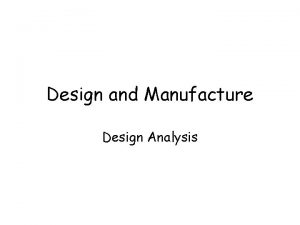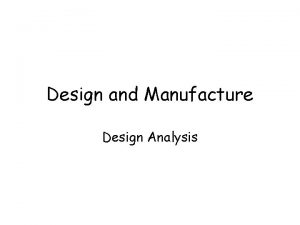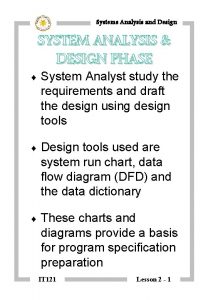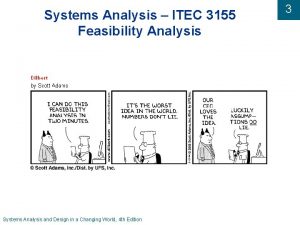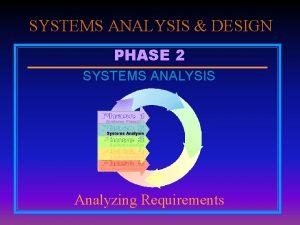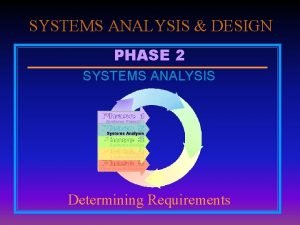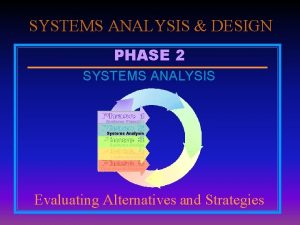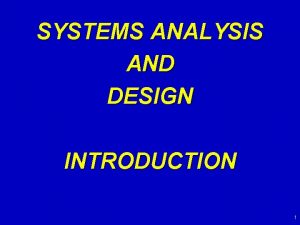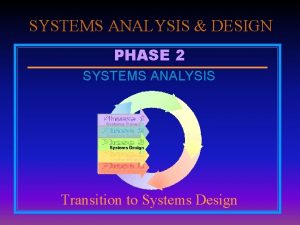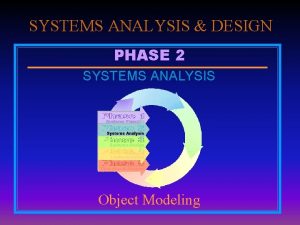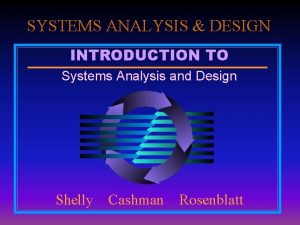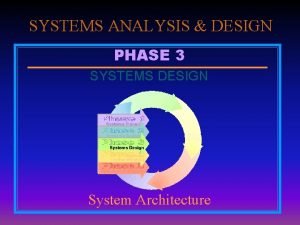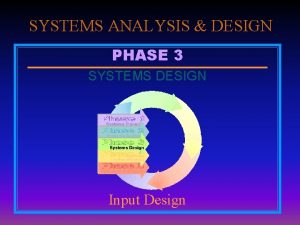Systems Analysis Design 7 th Edition Chapter 1




















































- Slides: 52

Systems Analysis & Design 7 th Edition Chapter 1 1

Chapter Objectives v Discuss the impact of information technology on business strategy and success v Define an information system and describe its components v Explain how profiles and models can represent business functions and operations v Explain how the Internet has affected business strategies and relationships v Identify various types of information systems and explain who uses them 2

Chapter Objectives v Explain modeling, prototyping, and CASE tools v Distinguish between structured analysis and object-oriented analysis v Compare the systems development life cycle waterfall model to adaptive models v Discuss the role of the information technology department and the systems analysts who work there 3

Introduction v Companies use information as a weapon in the battle to increase productivity, deliver quality products and services, maintain customer loyalty, and make sound decisions v Information technology can mean the difference between success and failure 4

The Impact of Information Technology v Information Technology – Combination of hardware and software products and services that companies use to manage, access, communicate, and share information – A vital asset that must be used effectively, updated constantly, and safeguarded carefully 5

The Impact of Information Technology v The Future of IT – Accounts for almost 30 percent of America’s economic growth, and the wage gaps between IT workers and all other workers will continue to widen – Global online population skyrocketed between 2000 and 2005 6

The Impact of Information Technology v The Role of Systems Analysis and Design – Systems Analysis and Design • Step-by-step process for developing highquality information systems – Systems Analyst • Plan, develop, and maintain information systems 7

The Impact of Information Technology v Who develops Information Systems? – – – – In-house applications Software packages Internet-based application services Outsourcing Custom solutions from IT consultants. Enterprise-wide software strategies How versus What • Grater risk if company tries To decide how system works Versus what system does 8

Information System Components v A system is a set of related components that produces specific results v A mission-critical system is one that is vital to a company’s operations v Data consists of basic facts that are the system’s raw material 9

Information System Components v Hardware – Moore’s Law v Software – – System software Application software Enterprise applications Horizontal system 10

Information System Components v Software – Vertical system – Legacy systems v Data – Tables – Linking 11

Information System Components v Processes – Define the tasks and business functions that users, managers, and IT staff members perform to achieve specific results – An analyst must understand document processes to build a successful information system. v People – Users, or end users, are the people who interact with an information system, both inside and outside the company. – The success of a system usually depends on 12 user satisfaction.

Understanding The Business – A system produces specific results. – To design any successful system, it is important to recognize the results desired and the processes needed to produce those results. – IT professionals must understand a company’s business operations in order to design a successful system. – Note that different businesses have different requirements Business process 13

Understanding The Business v Business Process Modeling v Business Profile v Business Models – Business model – Business process reengineering (BPR) 14

Understanding The Business v New Kinds of Companies – Production-oriented – Service-oriented – Internet-dependent – Dot-com (. com) – Brick-and-mortar 15

CASE IN POINT 1. 1: Cloud Nine Financial Advisors v Cloud Nine provides its clients with a monthly newsletter that offers recommendations about stocks to buy or sell. Doug Layton, Cloud Nine’s president, has asked your opinion on whether dotcom stocks might be good investments for the future. He specifically mentioned Google, e. Bay, Amazon. com, and Yahoo!, but he said you could suggest other companies. Doug wants you to do some Internet research to learn more about these Web-based companies and their future prospects. You can use a search engine, or start by visiting the Web sites of publications such as Forbes, Fortune Magazine, Business Week, or The Wall Street Journal, among others. 16

Impact of the Internet v v E-Commerce or I-Commerce C 2 C (Consumer-to-Consumer) B 2 C (Business-to-Consumer) B 2 B (Business-to-Business) – Company to company data sharing over internet to look for inventory or Electronic data interchange (EDI) – Extensible markup language (XML) • A flexible data description language that allows web-based communication between different hardware and software environment. – Supplier relationship management (SRM) • A B 2 B sites where buyers, sellers, distributors can offer products, submit specifications and transact businesses. 17

Impact of the Internet v Web-Based System Development – Web. Sphere • ( web development strategy used by IBM more detail on Chapter 6) –. NET • ( used by Microsoft) – Web services • like mortgage calculator offered by real sate web sites) 18

How Business Uses Information Systems v In past, IT managers divided systems into categories based on the user group the system served – – Office systems Operational systems Decision support systems Executive information systems 19

How Business Uses Information Systems v Today, it makes more sense to identify a system by its functions, rather than by users – – – Enterprise computing systems Transaction processing systems Business support systems Knowledge management systems User productivity systems 20

How Business Uses Information Systems v Enterprise computing systems – Support company-wide operations and data management requirements (Wal-Mart, Boeing and American airline use it for their inventory management ) v Transaction processing systems (TP) – Efficient because they process a set of transaction-related commands as a group rather than individually( shown in figure) 21

How Business Uses Information Systems v Business support systems – Provide job-related information to users at all levels of a company – Management information systems (MIS) – Radio frequency identification (RFID) – What-if 22

How Business Uses Information Systems v Knowledge management systems – Called expert systems – Simulate human reasoning by combining a knowledge base and inference rules – Many use fuzzy logic 23

How Business Uses Information Systems v User productivity systems – Technology that improves productivity • Email, voice mail, fax, video conferencing. – Groupware • run in the intranet and enable users to share data, collaborate on project and work in teams. v Information systems integration – Most large companies require systems that combine transaction processing, business support, knowledge management, and user productivity features (Example in below) 24

Information System Users and Their Needs 25

Information System Users and Their Needs v Top managers v Middle Managers and Knowledge Workers v Supervisors and Team Leaders v Operational Employees 26

Systems Development Tools and Techniques v Modeling – Business model or Requirements model, • describes the information that system must provide – Data model • Describes data structures and design – Object model • Describes objects, which combine data and structures and design – Network model • Describes the design and protocol of telecommunications link – Process model • Describes the logic that programmers use to write cod module 27

Systems Development Tools and Techniques v Prototyping – Prototype – Speeds up the development process significantly – Important decisions might be made too early, before business or IT issues are thoroughly understood – Can be an extremely valuable tool 28

Systems Development Tools and Techniques v Computer-Aided Systems Engineering (CASE) Tools – Also called computer-aided software engineering 29

Systems Development Methods v Structured Analysis – Systems development life cycle (SDLC) – Predictive approach • Since it is based on a detailed plan, similar to a blueprint for constructing a building – Uses a set of process models to describe a system graphically – Process-centered technique • Because it focuses on process that transform data into useful information 30

Systems Development Methods v Object-oriented Analysis – O-O analysis combines data & processes into objects – Object is a member of a class – Objects possess properties – Methods change an object’s properties – A message requests specific behavior or information from another object 31

Planning and Modeling a Systems Development Project v In addition to selecting a development method, system developers also must create a plan or model for the many tasks that will be required v Typically, the development team will use project management tools to help achieve the end result 32

Planning and Modeling a Systems Development Project v Comparison of Predictive and Adaptive Models – The SDLC usually is referred to as the waterfall model 33

Planning and Modeling a Systems Development Project v The SDLC Waterfall Model – Disadvantage in the built-in structure of the SDLC, because the waterfall model does not emphasize interactivity among the phases – This criticism can be valid if the SDLC phases are followed too rigidly – However, adjacent phases usually interact 34

Planning and Modeling a Systems Development Project v The SDLC Waterfall Model – Usually includes five steps • Systems planning • Systems analysis • Systems design • Systems implementation • Systems operation, support, and security 35

Planning and Modeling a Systems Development Project v Systems planning – Systems request – Purpose of this phase is to perform a preliminary investigation whose key part is a feasibility study v Systems Analysis – First step is requirements modeling – End product is the System requirements document 36

Planning and Modeling a Systems Development Project v Systems Design – Identify all outputs, inputs, and processes – End product is system design specification v Systems Implementation – New system is constructed – Users, managers, IT staff trained to operate and support the system – System evaluation performed 37

Planning and Modeling a Systems Development Project v Systems Operation, Support, and Security – A well-designed system must be secure, reliable, maintainable, and scalable – After several years of operation, systems need extensive changes – SDLC ends with system replacement 38

Planning and Modeling a Systems Development Project v Adaptive Methods and Models – Attempt to develop a system incrementally, by building a series of prototypes and constantly adjusting them to user requirements – Extreme Programming (XP) – Analysts should recognize that these approaches have advantages and disadvantages 39

Planning and Modeling a Systems Development Project v Joint Application Development and Rapid Application Development Methods and Models – Joint application development (JAD) – Rapid application development (RAD) v Other Development Methods and Models – Rational Unified Process (RUP®) – Microsoft Solutions Framework (MSF) 40

Planning and Modeling a Systems Development Project v The Importance of Project Management – Regardless of the development strategy, people, tasks, timetables, and expenses must be managed effectively – Complex projects can involve dozens of people, hundreds of tasks, and many thousands of dollars 41

Systems Development Guidelines v Stick to a plan v Involve the users throughout the development process v Listening is very important v Use project management tools to identify tasks and milestones v Remain flexible v Develop accurate cost and benefit information 42

Information Technology Department v The information technology (IT) department develops and maintains a company’s information systems v The IT group provides technical support 43

Information Technology Department v Application Development – Team may include users, managers and IT Staff members v Systems Support and Security – Deployment team v User Support – Help desk or information center (IC) • Train users and managers on application software. 44

Information Technology Department v Database Administration – Database design, management, security, backup, and user access v Network Administration – Includes hardware and software maintenance, support, and security v Web Support – Webmasters 45

Information Technology Department v Quality Assurance (QA) – Reviews and tests all applications and systems changes to verify specifications and software quality standards – Is a separate unit that reports directly to IT management 46

The Systems Analyst Position v A systems analyst investigates, analyzes, designs, develops, installs, evaluates, and maintains a company’s information systems v On large projects, the analyst works as a member of an IT department team v Smaller companies often use consultants to perform the work 47

The Systems Analyst Position v Responsibilities – Translate business requirements into practical IT projects to meet needs v Required Skills and Background – Solid communication skills and analytic ability 48

The Systems Analyst Position v Certification v Career Opportunities – – – Job titles Company organization Company size Corporate culture Salary, location, and future growth 49

Chapter Summary v IT is a combination of hardware, software, and telecommunications systems that support business v The essential components of an information system are hardware, software, data, processes, and people v Companies are production oriented, service oriented, or a combination of the two v Organization structure usually includes levels 50

Chapter Summary v Systems analyst use modeling, prototyping, and CASE tools v Various development methodologies exist v Regardless of the development model, it is important to use project management tools necessary to manage people, tasks, timetables, and expenses v An IT department develops, maintains and operates a company’s information systems 51

Chapter Summary v Systems analysts need a combination of technical and business knowledge, analytical ability, and communication v Chapter 1 complete 52
 Case tools are limited to systems analysis.
Case tools are limited to systems analysis. Modern systems analysis and design 7th edition
Modern systems analysis and design 7th edition Mis chapter 6
Mis chapter 6 Chapter 1
Chapter 1 Systems analysis and design in an age of options pdf
Systems analysis and design in an age of options pdf Systems analysis and design in a changing world
Systems analysis and design in a changing world Systems analysis and design in a changing world
Systems analysis and design in a changing world Systems analysis and design in a changing world
Systems analysis and design in a changing world System analysis and design alan dennis
System analysis and design alan dennis Introduction to systems analysis and design
Introduction to systems analysis and design Structured system analysis and design method
Structured system analysis and design method Modern systems analysis and design
Modern systems analysis and design Kendall and kendall system analysis and design
Kendall and kendall system analysis and design Systems analysis and design alan dennis
Systems analysis and design alan dennis Systems analysis and design alan dennis
Systems analysis and design alan dennis Systems analysis and design alan dennis
Systems analysis and design alan dennis Systems analysis and design alan dennis
Systems analysis and design alan dennis Systems analysis and design alan dennis
Systems analysis and design alan dennis Systems analysis and design alan dennis
Systems analysis and design alan dennis Systems analysis and design alan dennis
Systems analysis and design alan dennis Ssadm data flow diagram
Ssadm data flow diagram Radar range equation snr
Radar range equation snr Object-oriented systems analysis and design using uml
Object-oriented systems analysis and design using uml A modern approach to systems analysis and design
A modern approach to systems analysis and design Systems analysis and design kendall
Systems analysis and design kendall Kendall and kendall system analysis and design
Kendall and kendall system analysis and design Systems analysis and design in a changing world
Systems analysis and design in a changing world Systems analysis and design in a changing world
Systems analysis and design in a changing world Systems analysis and design in a changing world
Systems analysis and design in a changing world Systems analysis and design alan dennis
Systems analysis and design alan dennis Systems analysis and design alan dennis
Systems analysis and design alan dennis Systems analysis and design alan dennis
Systems analysis and design alan dennis Ssadm model
Ssadm model Essentials of systems analysis and design
Essentials of systems analysis and design Systems analysis and design in a changing world
Systems analysis and design in a changing world Systems analysis and design alan dennis
Systems analysis and design alan dennis List the five basic steps of ssa/sd process
List the five basic steps of ssa/sd process System analysis and design in a changing world
System analysis and design in a changing world Systems analysis and design in a changing world
Systems analysis and design in a changing world Radar system analysis and design using matlab
Radar system analysis and design using matlab Kendall and kendall system analysis and design
Kendall and kendall system analysis and design Principles of electronic communication systems 3rd edition
Principles of electronic communication systems 3rd edition Introduction to radar systems
Introduction to radar systems Introduction to information systems 6th edition
Introduction to information systems 6th edition Fundamentals of information systems 9th edition
Fundamentals of information systems 9th edition Fundamentals of information systems 9th edition
Fundamentals of information systems 9th edition Fundamentals of information systems chapter 1
Fundamentals of information systems chapter 1 Management information systems 16th edition
Management information systems 16th edition Management control systems 12th edition
Management control systems 12th edition Introduction to information systems 3rd edition
Introduction to information systems 3rd edition Introduction to management information systems 5th edition
Introduction to management information systems 5th edition Types of system architecture
Types of system architecture Principles of information systems, seventh edition
Principles of information systems, seventh edition


























